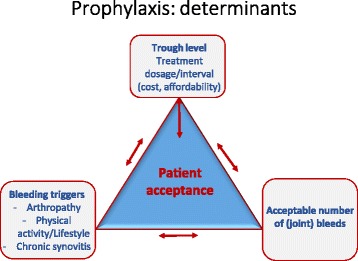Fig. 1.

Determinants of prophylaxis. Prophylaxis treatment regimen has 3 main determinants: (1) the given resources/concentrate availability/afffordability to target a specific trough level and/or dosage/intervals of infusions, all of which reflect the consumptions/costs; (2) the bleeding trigger, which comprises physical activity/lifestyle, presence and degree of arthropathy, and presence of chronic synovitis; and (3) the number of bleeds, especially joint bleeds, that are regarded as acceptable. These 3 determinants form a triangle. If 1 determinant is changed, the other 2 will adjust. Central to these, patient acceptability and ability to self-guided care must also be considered. With unlimited resources, “zero bleeds” and normal physical activity may be targeted. With few resources, only low-dose substitutions may be given, thus accepting a certain number of bleeds and limited physical activity. None-the-less where acceptable to the patient with adequate venous access, increasing frequency of infusion will attain a higher trough level with a lower dose (and hence consumptions/costs, see Fig. 2). Determinant 2 can also be improved by avoiding injury and by improving muscle strength and balance with exercise appropriate to the patients’ joint status. (Adapted from Oldenburg [17], with permission)
